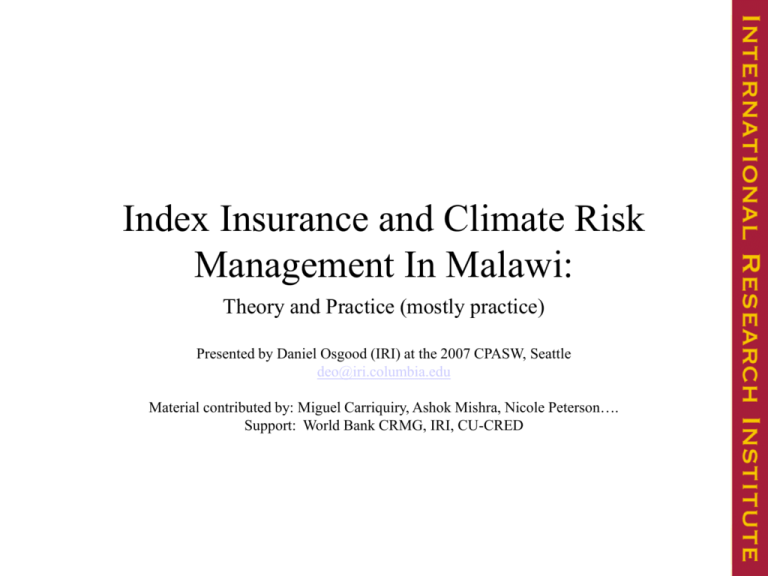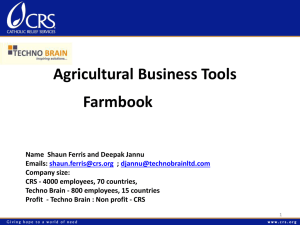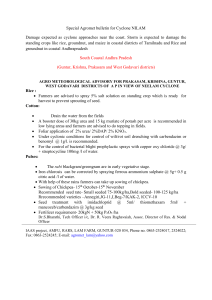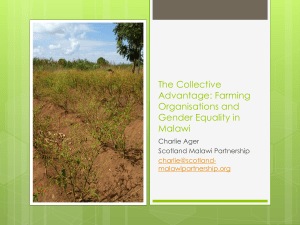Climate and Weather Related Insurance Systems in Africa
advertisement

Index Insurance and Climate Risk Management In Malawi: Theory and Practice (mostly practice) Presented by Daniel Osgood (IRI) at the 2007 CPASW, Seattle deo@iri.columbia.edu Material contributed by: Miguel Carriquiry, Ashok Mishra, Nicole Peterson…. Support: World Bank CRMG, IRI, CU-CRED Index insurance • • Insurance is an important link to allow use of climate information in decisionmaking Private Information problems with traditional crop insurance – Moral hazard (incentives to let crops die) – Adverse selection (farmers with secret weaknesses more likely to join) • The index innovation – – – – • Closely related to weather derivatives Insure weather index (such as seasonal rainfall), not crop Only partial protection (basis risk), should not oversell Cheap, easy to implement, good incentives Design complex: only a naive partner would reveal all their cards – All partners must play active role in a cooperative design process • Price: Money in = average(Money out) + cost of holding risk – EG: Ave(Payout) + 0.065 * 0.06 (99th % payout – Ave(Payout)) – This price must < value to client for market to exist – Only clients really know personal value (their info may be used against them) Index issues, risk layering, basis risk • Not only to farmers for crop loss using rainfall • Broad applications, in principal – Temp, rainfall, degree days, wind, SST, reservoir level, model output, remote sensing – Not limited to target group • Not comprehensive--target cost effective parts of risk • Index protects some people from some risks – Risk management needs other solutions for other risks, players – Build risk layering system • Eg: farmer, group, cooperative, micro-lender, government, re-insurer • Only partial coverage--must not oversell • But an important link in climate risk management • This application is development oriented NOT famine relief Some projects • India – • BASIX, hundreds of thousands of farmer transactions completed in only about 4 years Ethiopia – Drought famine relief (client: national government, first transacted 2006) • – • Crop loss micro-insurance (client: <100 farmers, piloted 2006) Malawi – – Drought relief (insurance/price options, client: national government) Farm level crop loss, bundled contracts • • • • Example of early action system/trigger policies initially ~900 farmers, 2005 We designed 2006 contracts in operation now, several thousand contracts Working on projects for 2007 in Kenya, Tanzania, MVP, Central America Experimental 2007 pilot precip/NDVI for selected counties’ rangelands in US (subsidized) – http://www.rma.usda.gov/policies/pasturerangeforage/ , NOAA CPC, EROS data World Bank CRMG, Re-insurance companies, WFP highly involved Micro loans • Insurance, credit, savings complement each other – Insurance for uncertainty (useless without uncertainty) – Uncertainty hurts credit markets • Work better together – Insurance can make loans to riskier clients possible – “Traditional” microfinance strategy of relying on group liability is vulnerable to widespread drought • Package of microfinance insurance, credit, savings • Bundle contracts – Lender packages insurance in loan, so farmer can use insurance if dry – Seed provider packages insurance in seed sale, so farmer gets payment if seed fails due to drought Groundnuts from farmer in Malawi program Maize of farmer in groundnut program (not yet program Maize) Malawi Groundnut contract bundle • Farmer gets loan (~4500 Malawi Kwacha or ~$35) that covers: – Groundnut seed cost (~$25, ICRSAT bred, delivered by farm association) – Interest (~$7), Insurance premium (~$2), Tax (~$0.50) – Prices vary by site • Farmer holds insurance contract, max payout is loansize – Insurance payouts on rainfall index formula – Joint liability to farm “Clubs” of ~10 farmers – Farmers in 20km radius around met station • At end of season – Farmer provides yields to farm association – Proceeds (and insurance) pay off loan – Remainder retained by farmer • Farmers pay full financial cost of program • Only subsidy is data and contract design assistance • Partners: Farmers, NASFAM, OIBM MRFC, ICRSAT, Malawi Insurance Association, the World Bank CRMG, Malawi Met Service, IRI, CUCRED Some Stakeholders Graphical representation of Insurance Contract developed with Farmers Nicole Peterson, CRED Contract design? • Different simulation strategies provide different results • Historical yield data scarce and unreliable, for different varieties, different inputs • Private information inherent to design problem: – Only naïve players show all of their cards – We do not know risk preferences, productivity, self-insurance, production details, consumption needs, hedging strategies, other sources of income, if having new child year… • So we cannot run ‘ideal’ optimization • But we must design contracts Cooperative Design Strategy Chitedze Groundnut Simulations Ashok Mishra Cooperative design steps • • • Stakeholders choose maximum insurance price Use qualitative knowledge of vulnerability to set initial guess for optimizer Computer optimization (really just “tuning”): – WRSI based simulation of losses (using historical precip) – Optimize upper triggers to: • Minimize variance of (losses - insurance payments) • Subject to specified maximum insurance price (can get great correlation at high price) • • • Compare contracts performance against array of simulations and historical data, looking for contract vulnerabilities. Would most payouts have occurred in most of the worst years of history, for right reasons? Communicate results with stakeholders, iterate, and manually adjust contracts to address requests, reporting price, payout, and correlation impacts of changes. Chitedze Groundnut Loss based on Daily WRSI, seasonal KY 4000 2000 0 loss 6000 Loss Pay Loss-Pay+E[Pay] 1970 1980 1990 years 2000 Loss Pay Loss-Pay+E[Pay] 1500 1000 500 0 loss 2000 2500 3000 Chitedze Groundnut Historical Loss 1992 1994 1996 years 1998 2000 2002 Loss Pay Loss-Pay+E[Pay] 2000 0 loss 4000 6000 Chitedze Groundnut Simulated 1970 1980 years 1990 2000 Chitedze Groundnut example analysis • Upper triggers: 35 35 220 • Lower Triggers: 30 30 20 • Price rate (target, actual): 0.07, 0.083 Pearson’s Correlation Years Payouts % Payyears in % drop in var worst 1/4 (arbitrary) WRSI 0.54 45 9 78 21 Historical Yields (all Groundnut) 0.66 12 4 50 40 Crop simulation 0.30 43 8 50 9 Ranking of losses and payouts [,1] [,2] [,3] [,4] [,5] [1,] 1995 7641.140 1 3132.5 1.0 [2,] 1973 6542.680 1 312.5 7.0 [3,] 1966 6324.398 0 0.0 27.5 [4,] 1996 6315.617 1 2177.5 2.0 [5,] 1990 5903.817 0 0.0 27.5 [6,] 1984 5660.633 1 1467.5 3.0 [7,] 2005 5598.026 1 275.0 8.0 [8,] 1970 4929.469 1 1232.5 4.0 [9,] 1992 4904.982 0 0.0 27.5 [10,] 1997 4459.438 1 555.0 6.0 [11,] 1968 4400.516 0 0.0 27.5 [12,] 1969 4296.916 1 72.5 9.0 [13,] 1980 4235.219 0 0.0 27.5 [14,] 1994 4136.128 0 0.0 27.5 [15,] 2004 3921.972 0 0.0 27.5 [16,] 1979 3513.749 0 0.0 27.5 [17,] 2000 3399.898 0 0.0 27.5 [18,] 1983 3399.299 0 0.0 27.5 [19,] 2001 3367.294 0 0.0 27.5 [20,] 2006 3347.076 0 0.0 27.5 [21,] 2002 3218.283 1 1100.0 5.0 [22,] 1967 3070.731 0 0.0 27.5 [23,] 1962 0.000 0 0.0 27.5 [24,] 1963 0.000 0 0.0 27.5 [25,] 1964 0.000 0 0.0 27.5 [26,] 1965 0.000 0 0.0 27.5 [27,] 1971 0.000 0 0.0 27.5 [28,] 1972 0.000 0 0.0 27.5 [29,] 1974 0.000 0 0.0 27.5 [30,] 1975 0.000 0 0.0 27.5 [31,] 1976 0.000 0 0.0 27.5 [32,] 1977 0.000 0 0.0 27.5 [33,] 1978 0.000 0 0.0 27.5 [34,] 1981 0.000 0 0.0 27.5 [35,] 1982 0.000 0 0.0 27.5 [36,] 1985 0.000 0 0.0 27.5 [37,] 1986 0.000 0 0.0 27.5 [38,] 1987 0.000 0 0.0 27.5 [39,] 1988 0.000 0 0.0 27.5 [40,] 1989 0.000 0 0.0 27.5 [41,] 1991 0.000 0 0.0 27.5 [42,] 1993 0.000 0 0.0 27.5 [43,] 1998 0.000 0 0.0 27.5 [44,] 1999 0.000 0 0.0 27.5 [45,] 2003 0.000 0 0.0 27.5 Stakeholder input drives contracts • Look for: – Do stakeholders understand contracts? – Do stakeholders show evidence of negotiating in their own interests? – Do stakeholders understand basis risk and what is not covered? – Look for insightful complaints • Malawi stakeholders have been very active, driven design – Original CRMG project proposal was for stand alone Maize Insurance – Malawi stakeholders proposed groundnut bundle Some Malawi Project Challenges • Basis risk – Seed quality – Aflotoxin – Rainfall spatial variability • Seed and Yield prices • Repayment • Scaling challenges – Station availability, history – How do you responsibly include thousands of new farmers? • Financial recordkeeping quality • Compatibility with government subsidy programs Seasonal forecasts, long term trends, and climate change • Seasonal forecast and index insurance interact – Difficult to take chance using forecast if livelihood at stake • Well designed insurance can take risk out of forecast • Maps probabilistic forecast to deterministic outcome • Farmers (banks) can take intensification chances for higher productivity – Insurance can communicate forecasts and risk costs as price signal – Seasonal forecast makes badly designed insurance insolvent • Well designed insurance robust to forecast • “Low skill” forecasts/indices can have high skill for insurance specific decisions • Can climate science “guarantee” no skill? Exploratory analysis: Hypothetical Historical Payouts of Drought Insurance 2005 Contracts for Groundnuts in Lilongwe, Malawi 1800 Payout (Kwacha) 1600 1400 1200 1000 800 600 400 200 0 1961 1966 1971 1976 1981 Year Miguel Carriquiry 1986 1991 1996 2001 Exploratory Analysis: Standardized Seasonal Rainfall Anomaly Predictions (October) vs Payouts from Groundnut Insurance 1800 1600 Payout (Kwacha) 1400 1200 1000 800 600 400 200 Predicted anomaly (standardized) Miguel Carriquiry 1.45 1.15 0.82 0.69 0.59 0.44 0.33 0.25 0.22 0.16 0.03 -0.1 -0.3 -0.5 -0.7 -1 -1.1 -1.2 0 Visions for climate risk management • Malawi farmers – Knew about Enso impacts on precipitation – Would like to adjust practices to take advantage of seasonal forecasts but are unable to obtain appropriate fertilizer and seed – We are researching and cooperatively developing packages that provide price incentives, risk protection, and strategic input availability so farmers can take advantage of forecasts – No ‘historical’ payouts for La Nina years for many stations – ICRSAT would like to develop seeds to compliment these packages – Fundamental research on insurance, production, and forecast necessary – When asked how they adapt to climate variability and change farmers reported that they signed up for the index insurance program. Climatology important • Northern and Southern Malawi – “opposite” Enso phase response – Location of north-south dividing line challenging to forecast • But climate info still very valuable for insurance • Potential for natural hedge – By strategic pooling of contracts from the north and south, total risk can be reduced, reducing costs of insurance – Research underway (Megan McLaurin . . .) – Pool Kenya with Malawi? – Negative correlations, forecast critical in Central America • We are building integrated data/contract design web tools Example of ENSO based pricing El Niño La Niña Neutral All Insurance Rate 0.1568 0.0179 0.1114 0.1198 Insurance Price (MKW) 702.90 702.90 702.90 702.90 3515.25 30915.85 4949.38 4602.90 966.69 8501.86 1361.08 1265.80 Input Budget (MKW) 2812.35 30212.95 4246.48 3900 Maximum Liability (MKW) 4481.94 39417.71 6310.46 5868.69 0.72 7.75 1.09 1 Loan (MKW) Interest (MKW) Input Budget Weight Preliminary results—do not cite Example gross revenue calculations Insurance/Loan package--ENSO based pricing PRELIMINARY RESULTS—do not cite Non-Hybrid ENSO shifted Land Allocation Based on Historical District Yields 150000 Scaled Package Based on simulated yield 100000 50000 Gross Revenue (MKW) 8 e+05 4 e+05 Enso Based Standard 0 e+00 Gross Revenue (MKW) Enso Based Standard 1970 1980 Year 1990 2000 1985 1990 1995 Year 2000 Gross Revenue Simulations Simulation based Standard (MKW) Enso based (MKW) Enso/Standard Historical Yields Mean Min Max Var 89034.88 -5868.69 145951.31 1902719400 246798.42 -6310.46 1113942.41 106489037713 2.6663 0.9923 7.1810 55.97 Mean Min Max Var Standard (MKW) 12977.79 6682.94 19932.01 14850032 Enso based (MKW) 37129.32 6565.28 152822.54 2584196785 2.8610 0.9824 7.6672 174.0196 Enso/Standard I’m Mrs Timange Mateyo Kalitsiro from the Chiponde GAC, Chiwamba Association and one of the Volunteers of Gender and HIV. I would like to talk about the Chalimbana 2000 Groundnut variety. This type of ground nut is high yielding. But, we had a seed problem. Not all the seed that we planted germinated. This is what caused us not to achieve the normal high yield expected from Chalimbana 2000. We hope that if we can be given a good seed this coming season, we will be able to harvest high yields. Chalimbana 2000 is different from the ordinary Chalimbana . If we can be given good seed and take a good care of our gardens we can benefit a lot from this crop. We wanted to know more about insurance. What is the meaning of insurance? We did not know much about this insurance, but now through the explanation that has been given to us by the agricultural advisors and visitors who came here at Chiwamba, now we have understood how this insurance works. We will be able to explain to our friends how the insurance works and how we can benefit from it in the time of disaster. Our request is that the insurance should not only cover rain disaster but also other agricultural problems. We the farmers, we are ready to work with you for the success of the project, and the insurance coverage will help us when we have a disaster. We farmers from Chiwamba, we promise to work hard if we are given the farm inputs in good time and plant with the first planting rain, we will have enough time to take care of the crops at the end we will have enough yields. Thank you (Zikomo)








